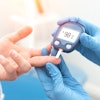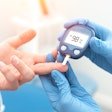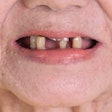U.S. researchers have created a new type of biosensor that can detect minute concentrations of glucose in saliva, tears, and urine, and might be manufactured at low cost because it does not require many processing steps to produce (Advanced Functional Materials, August 21, 2012, Vol. 22:16, pp. 3399-3405).
"It's an inherently noninvasive way to estimate glucose content in the body," said Jonathan Claussen, PhD, a former Purdue University doctoral student and now a research scientist at the U.S. Naval Research Laboratory, who led the research project, in a press release. "Because it can detect glucose in the saliva and tears, it's a platform that might eventually help to eliminate or reduce the frequency of using pinpricks for diabetes testing."
The sensor has three main parts: layers of nanosheets made of graphene, platinum nanoparticles, and the enzyme glucose oxidase. Electrodes are formed by combining the nanosheets and platinum nanoparticles. Then the glucose oxidase attaches to the platinum nanoparticles. The enzyme converts glucose to peroxide, which generates a signal on the electrode.
"Typically, when you want to make a nanostructured biosensor, you have to use a lot of processing steps before you reach the final biosensor product," said Anurag Kumar, a Purdue doctoral student. "That involves lithography, chemical processing, etching, and other steps. The good thing about these petals is that they can be grown on just about any surface, and we don't need to use any of these steps, so it could be ideal for commercialization."
The technology is able to detect glucose in concentrations as low as 0.3 micromolar, far more sensitive than other electrochemical biosensors based on graphene or graphite, carbon nanotubes, and metallic nanoparticles, Claussen said.
In addition to diabetes testing, the technology might be used for sensing a variety of chemical compounds to test for other medical conditions.
"Because we used the enzyme glucose oxidase in this work, it's geared for diabetes," Claussen said. "But we could just swap out that enzyme with, for example, glutemate oxidase, to measure the neurotransmitter glutamate to test for Parkinson's and Alzheimer's, or ethanol oxidase to monitor alcohol levels for a breathalyzer. It's very versatile, fast, and portable."


















